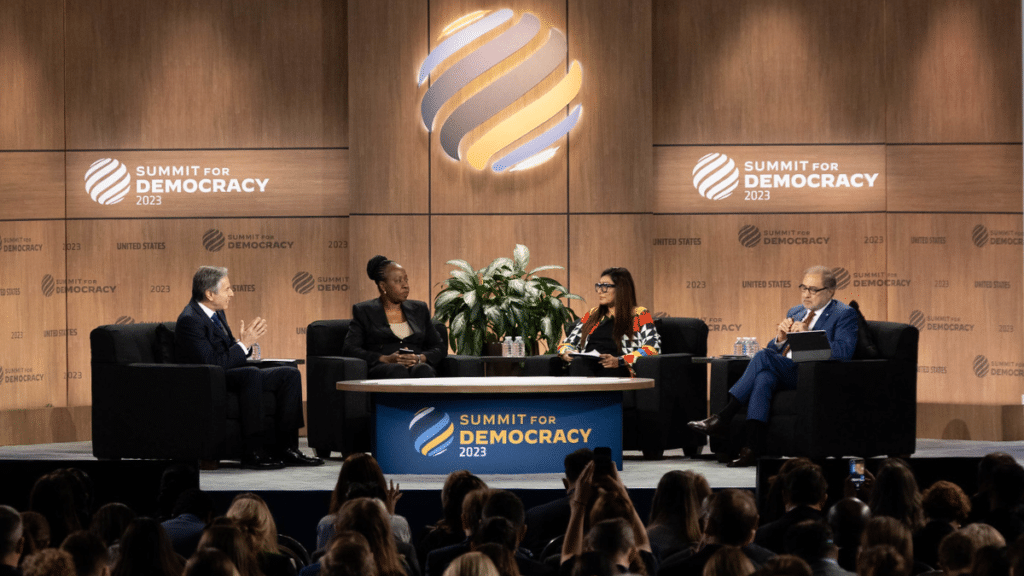Eight Takeaways on Tech from the Summit for Democracy
Alex Engler / Mar 31, 2023Alex C. Engler is a Fellow at the Brookings Institution and an Associate Fellow at the Center for European Policy Studies, and teaches AI policy at Georgetown University, where he is an adjunct professor and affiliated scholar.

The second Summit for Democracy, the flagship convening for the Biden administration’s pro-democracy policy agenda, ended yesterday. The event, co-hosted by the Republic of Korea, the Republic of Zambia, Costa Rica, and the Netherlands, covered a range of topics—but highlighted prominently was the intersection of technology and democracy. With these global partners, the United States is deepening its work on an explicitly pro-democratic technology policy agenda. This round-up gives an early sense of how the Biden administration’s efforts are starting to cohere into a new, and far more proactive, approach to democracy in the digital age.
Improving (1) digital public services played a prominent role across the event. Diaa, a cloud-based smart phone app for public services, was lauded for its role in keeping the Ukrainian government working. Yet the value of digitizing public services extends far past the disruptions of war—it’s a universally important element of ensuring public trust in democratic governance. It is easy to compare antiquated public services with rapidly improving private sector technology, and find the government lacking. This is likely contributing to a troubling status quo. Across 34 nations, a median of 52% of residents are dissatisfied with the function of their democracy. A few modernizing democracies are worth highlighting, including the oft-mentioned Estonia, as well as Taiwan and the Republic of Korea (the host of the next summit), both of which are pushing the envelope to make government services more transparent, accessible, and proactive.
Yet many countries are struggling to digitize, even as the COVID pandemic has demonstrably increased demand for digital public services. So how can a global partnership help? One way is by committing to share open-source and re-usable building blocks of digital services, helping other countries follow in the footprints of successful digital governments. Many governments share meaningful goals, such as enabling access to public services and tracking government spending or procurement. By sharing high-quality and well documented pieces of software, governments can collaboratively speed global technology adoption. This theme was prevalent at the summit, building on the efforts of the Digital Public Goods Alliance and new funding commitments to digital infrastructure following the September UN General Assembly.
(2) Expanding internet access was another key theme. Secretary of State Antony Blinken cited millions in U.S. financing to help Rio de Janeiro expand public Wi-Fi. The Biden administration also elevated the work of Main One, which has built a submarine communications cable from Portugal to Senegal, the Ivory Coast, Lagos, and Nigeria. Speaking at the event, Main One CEO Funke Opeke cited the liberalization of the telecommunications industry, such as in Nigeria, as a key factor in enabling the expansion of internet access in West Africa. Despite this progress, internet penetration in Africa remains low—Opeke and others explicitly argued that expanding internet access dilutes the informational control of authoritarian states.
An undercurrent to expanding global internet access was the (3) continued use of internet shutdowns as a means of authoritarian information control. A report from Access Now and an associated coalition identified 187 internet disruptions in 2022 across 34 countries, with 84 of those instances in India. Freedom House’s 2022 Freedom on the Net report is a bit more optimistic, record notable reductions in the throttling of internet services, which the report attributed to proactive advocacy campaigns and emerging global norms opposing internet shutdowns. Neither analysis is wholly comprehensive, as measurement of internet restriction remains a truly difficult challenge. However, new efforts, such as Internet Society Pulse, are measuring internet restrictions with more geographic granularity. These measures also have an eye towards the economic downsides of shutdowns, which can be part of a compelling argument against their use. Reducing the use of internet restrictions remains a high priority in the pro-democratic technology policy space, especially as many of these shutdowns coincide with human rights abuses. The United Kingdom has been leading a new task force on reducing internet shutdowns within a reinvigorated Freedom Online Coalition.
Internet shutdowns are not the only government practice that undermines democracy—also prevalent in the conversation was the (4) use of surveillance technologies. Just a few weeks ago, Steven Feldstein of the Carnegie Endowment released an impressive new report on the global spyware industry, arguing that democracies “have been inconsistent in tackling the human rights abuses enabled by spyware.” Yet perhaps there is room for renewed optimism. On Monday of this week, the Biden administration released a new executive order on commercial spyware. The EO relies on the power of the purse—if spyware vendors sell to repressive governments or has been used against U.S. citizens of the government, that vendor will no longer be allowed to receive federal contracts. John Scott-Railton of Citizen Lab said the new EO is “the first comprehensive action by any government on spyware,” although he noted that it doesn’t affect state and local government contracts, among other caveats. This new EO furthers earlier administration actions, such as the addition of foreign spyware companies, most notably Israel’s NSO Group, to a government blacklist.
As an aside, this topic was the subject of perhaps the most engaging discussion of the summit. Consider watching this panel on repressive technologies, moderated by Marietje Schaake and featuring John Scott-Railton, U.S. Director of National Intelligence Avril Haines, and YouTube CEO Neal Mohan. Fellow spectator Nathalie Maréchal suggested to me that this was a uniquely candid and introspective discourse, and I agree.
Beyond curtailing authoritarian technology, a range of endeavors also highlighted (5) democracy affirming technologies, a nebulous neologism for tools that advance some democratic values. At an associated event, the Tech4Democracy Global Entrepreneurship Challenge highlighted innovative technology start-ups aimed at advancing democracy around the world. This included Trustur, an African civic technology company aimed at expanding financial inclusion and public benefits access. Another company, Atlos, has developed a new database and platform tailored to the needs of visual investigations, which is currently being used to document human rights abuses in Ukraine.
A prepared video at the summit also highlighted the winners of the U.K.-U.S. Privacy Enhancing Technologies Challenge, which aims to foster new approaches to large scale data analysis, such as in financial crime detection, while maintaining some privacy protections. Earlier this week, Acting National Cyber Director Kemba Walden announced new government funding for anti-surveillance technology would be coming soon, building on the successful history of the Open Tech Fund, which has supported censorship-evading tools like Signal and Tor. Other examples mentioned were the Starlink terminals being smuggled into Iran, as well as Lantern, a peer-to-peer network expanding internet access in Russia.
Lastly, the specter of (6) emerging AI challenges crept into the conversation. White House Office of Science and Technology Policy (OSTP) Director Dr. Arati Prabhakar cited the Blueprint for an AI Bill of Rights, alluding to the need for algorithms to be non-discriminatory, and therein capable of performing well for all the communities in modern pluralistic democracies. Dr. Prabhakar also argued that “we need AI to do much more than just serve business interests, we need applications that also serve the public good,” while advocating for a National AI Research Resource intended to build the public infrastructure necessary to develop large AI models. Among attendees, AI in criminal justice was also a common concern—from the purported use of algorithms to assign politically sensitive court cases to specific judges in Poland, to the broad lack of governmental standards on the use of facial recognition. Generally, AI wasn’t portrayed as the most immediate concern—which is appropriate, as its impact on global democracy does not yet equal the central roles of the other topics mentioned here.
So, if these themes were prominent, what digital issues were missing from the Summit for Democracy? Overall, the events felt light on (7) platform governance. Secretary Blinken did raise the issue of disinformation, and reiterated President Biden’s call to “hold platforms accountable,” but few specifics followed. USAID Director Samantha Power noted that her agency will partner with the State Department on a new initiative to support “pre-bunking” technologies to flag manipulated content and strengthen information integrity.
Several panelists and attendees mentioned the value of a legal framework from democratic governments on platforms. However, nothing seems forthcoming from the U.S. along the lines of the EU’s Digital Services Act. This is perhaps troubling, as several attendees mentioned to me, because recent layoffs at technology companies may be adversely affecting platform integrity efforts. This is a significant hole in democratic technology reform, but the Biden administration is limited without Congressional action. Now might be a relevant moment to mention the non-participation of Republicans on the summit stage.
That being said, the general reaction to the Summit for Democracy was, and should be, positive. Since the first Summit for Democracy, the U.S. has (8) reengaged with civil society and multi-stakeholder efforts, such as by taking on the chair of the Freedom Online Coalition and successfully campaigning to lead the UN’s technology agency. Through the Trade and Technology Council, the EU and U.S. are jointly increasing funding to organizations that protect journalists and civil society from digital threats. In addition to reaffirming principles, such as through the Declaration for the Future of the Internet, the Biden administration has invested in administrative capacity, such as the State Department’s new Bureau of Cyberspace and Digital Policy.
The ongoing challenges of democratization and digitalization remain daunting, but it should now be clear that the Biden administration’s efforts on pro-democracy technology are far more than window dressing—and they were on full display at the second Summit for Democracy.
Authors
